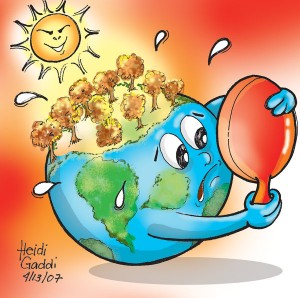Climate change is an element in our world which has been around for many years. It has been believed to cause warmer oceans and erratic weather, but a new study, according to scientists, declares it also has the potential to alter the shape of the planet we live in. Global Warming is a gradual increase in the overall temperature of the earth’s atmosphere generally attributed to the greenhouse effect caused by increased levels of carbon dioxide, chlorofluorocarbons, and other pollutants. (read more about Global Warming) Michele Koppes, assistant professor in the Department of Geography at the University of British Columbia, conducted a five year study in which she compared glaciers in Patagonia and in the Antarctic Peninsula. Koppes and her team discovered that glaciers in warmer Patagonia moved faster and caused more erosion than those in Antarctica, as warmer temperatures and melting ice helped lubricate the bed of the glaciers.
Glaciers erode 100 to 1,000 times faster in Patagonia than they do in Antarctica. “Antarctica is warming up, and as it moves to temperatures above 0 degrees Celsius, the glaciers are all going to start moving faster,” states Koppes. These ice sheets are apparently beginning to move faster and should become more erosive. As a result, this will dig deeper valleys and shed more sediment into the oceans. The outcomes of this erosion add to the already complex effects of climate change in the polar regions. “The polar continental margins in particular are hotspots of biodiversity, If you’re pumping out that much more sediment into the water, you’re changing the aquatic habitat,” Koppes states. The Canadian Arctic, one of the most rapidly warming regions of the world, will most definitely feel these effects. These glaciers are on the verge of a major shift. The Canadian Arctic is becoming warmer in temperature more than four degrees Celsius spanning over the last 50 years. These glaciers will be flowing up to 100 times faster if the climate continues to shift and shifts above zero degrees Celsius. The findings by Koppes settle a scientific debate about when glaciers have the greatest impact on shaping landscapes and creating relief, suggesting that they do the most erosive work near the end of each cycle of glaciation, rather than at the peak of ice cover. If global warming continues to occur, change in formation of landscape due to higher water levels from melting glaciers is a strong possibility and may already be taking place. This will significantly affect all forms of life on earth.
Original Article: http://www.sciencedaily.com/releases/2015/10/151001142222.htm
Citations:
http://www.whoi.edu/main/topic/global-warming
http://www.sciencedaily.com/releases/2015/10/151001142222.htm



Leave a Reply